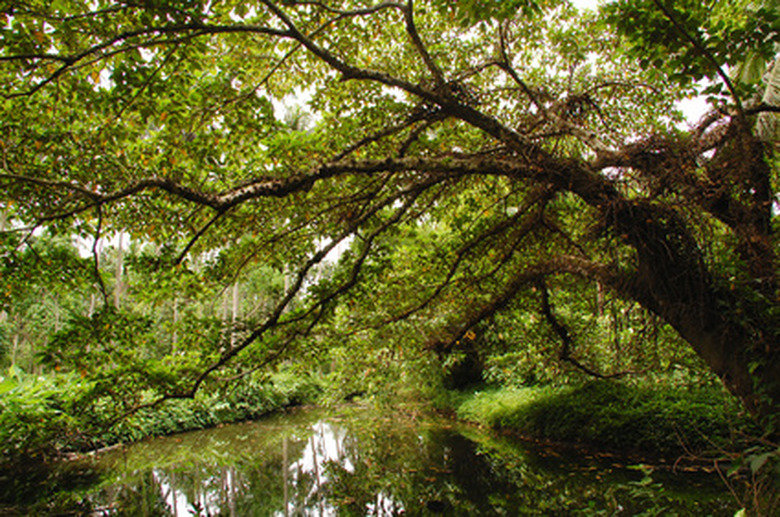Plants In The Florida Swamp
Florida swamps are a diverse ecosystem that provide habitat for wading birds during the migration season, as well as endangered species such as black bear, mink, panther and fox squirrel. Various types of plants, as well, thrive in the wetlands of the Sunshine State. Swamps may be classified as stillwater or river swamps, depending on the source of water.
Trees
Cypress trees are the most common type of tree found in Florida swamps, followed by Water Tupelo and Black Gum trees. Cypress and Tupelo trees are usually swollen at the point in which they are submerged in swamp water. These trees have adapted to the Florida swamp by developing pneumatophores, or root appendages that extend upward. These roots allow the trees to obtain oxygen, which they would be unable to do if constantly under water. A few varieties of palm trees also survive in Florida swamps, the Florida Royal Palm being the most common. A great number of these palm trees are found in the Everglades National Park.
- Florida swamps are a diverse ecosystem that provide habitat for wading birds during the migration season, as well as endangered species such as black bear, mink, panther and fox squirrel.
- Cypress trees are the most common type of tree found in Florida swamps, followed by Water Tupelo and Black Gum trees.
Vines
Greenbrier and poison ivy are two common vines found in Florida swamps. Greenbrier vines have very long pointed leaves with two rounded ears at the top. These leaves are prickly around the edges, and green with occasional yellow spots. Poison ivy vines grow along the sides of trees in Florida swamps. These vines are characterized by clusters of three leaves that are shiny green and later turn dull. Poison ivy vines have tiny white flowers that form in a cluster with a white berry in the center. This vine can cause rashes and itching if the leaves are allowed to come in contact with the skin.
- Greenbrier and poison ivy are two common vines found in Florida swamps.
- Greenbrier vines have very long pointed leaves with two rounded ears at the top.
Insect-Eating Plants
Bladderwort, sundew, butterwort and pitcher plants are insect-eating plants found in Florida swamps. Bladderworts stems with yellow flowers and float on water. These flowers have tiny hairs that act as triggers whenever an insect lands on them, causing the bloom to close and digest the insect. Pitcher plants are vines with hanging pouches. Water stands inside the pouch, which also contains digestive enzymes. Insects are attracted to the moisture in the pouch and become trapped. Sundew plants have tentacles with a sticky substance for trapping flying insects. Butterwort has long green leaves, low to the ground, with a sticky substance that traps crawling insects.
- Bladderwort, sundew, butterwort and pitcher plants are insect-eating plants found in Florida swamps.
- Sundew plants have tentacles with a sticky substance for trapping flying insects.
Invasive Plants
Even though swamps contain little oxygen and sunlight, Florida swamps are nonetheless home to several invasive species. The Old World climbing fern is growing rapidly in Florida swamps. It quickly grows up the side of Cypress trees, eventually smothering them. Ferns also allow fires to spread to tree tops easily. The Brazilian pepper tree, first brought to this country as an ornamental tree, is now taking over some areas of the Florida swampland. It prevents the growth of other plants by crowding them out of their spaces. It may also produce a chemical that is offensive to native plant species and inhibits their growth.
- Even though swamps contain little oxygen and sunlight, Florida swamps are nonetheless home to several invasive species.
- It prevents the growth of other plants by crowding them out of their spaces.
